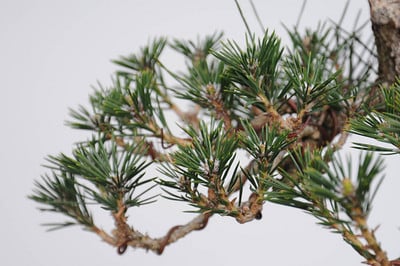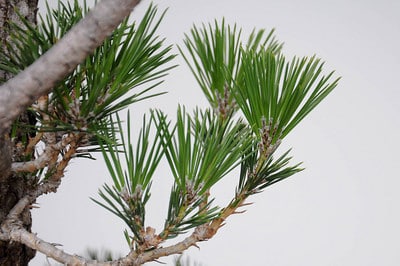It’s common to divide a tree’s shoots into three zones based on strength during decandling season. A long-term project of mine had me dividing a tree into three zones for very different reasons.

Japanese black pine – after decandling
The lowest third of this sixteen year-old Japanese black pine is beginning to develop branches that will be used in the final design of the tree – these I decandled. The top third of the tree – two vigorous sacrifice branches – are not decandled. These branches are facilitating future grafts by providing scions and keeping sap flowing past the spots where I need to graft.
The branches growing from the middle of the trunk will comprise the apical branches. I’m keeping the spring shoots here to facilitate approach grafts next season. I’ve never tried approach grafts with black pine and am curious to give it a try.

After decandling

After decandling – first branch on the left

Decandled branch

Spring shoots retained for approach grafting next year
What I’m most looking forward to is removing the top half of the trunk. I’ll do this a year or two after I can get grafts to take near the top of the tree. Then, another five years of decandling or so and the tree may be ready for exhibit at a young 20-25 years old.
Subscribe to Bonsai Tonight
New Posts Delivered Every Tuesday and Friday
Mark says
I don’t think what you’re doing is called (de)candling. Candles on JBP look like these: http://botanysaurus.com/jg/kumamotoen_clip_image002.jpg . The needles on yours are already well developed and, therefore, called shoots. And what you’re doing is called pruning (or pinching at best).
xwires says
Hi Mark – you’re right about “candles” referring to shoots before new needles emerge. I’ll guess “decandling” became the term most commonly referred to for removing spring growth because “de-shooting” sounds silly. Also, one may remove shoots earlier in the season when the new growth most resembles “candles,” however, removing growth this early has a very different effect on bonsai. What I don’t know is the Japanese term for “decandling” – that may shed light on the convention.
When talking about this practice, one typically “decandles” a pine by removing the new “shoots.”
Mark says
So why not call it pruning or pinching like I suggested? Overloading terms just increases confusion. Let’s call candles candles and shoots shoots.
chuhin says
Mark,
the term pinching candle already exist for black pine technique. it is to break it partially when it is still at candle stage like your link. it is to equalize the energy before decandling in early summer.
you will need to study and understand the term or you can write your own new book.
chuhin says
Jonas,
thanks for great info.
Mark says
Yes, chuhin, it is “to break it partially when it is still at candle stage”, as you say.
But that’s not everything. Some, in fact almost all of the strongest candles are removed in their entirety (hence the term (de)candling), some (usually the weakest ones) are left intact, and some (of, say, medium strength) are broken off at various lengths. The latter is also called pinching. Oh, and – yes – It’s in the books. 😉
Chuhin says
Mark,
it looks like you read a lot of bad books.
The technique you just mentioned is correct technique but it is for five needle pine.
Good luck with your bonsai training.
Mark says
Classification into areas according to growth strength is the same for three and five needle pines. Only the time schedule is different.
Good luck with your training, too, Chuhin.